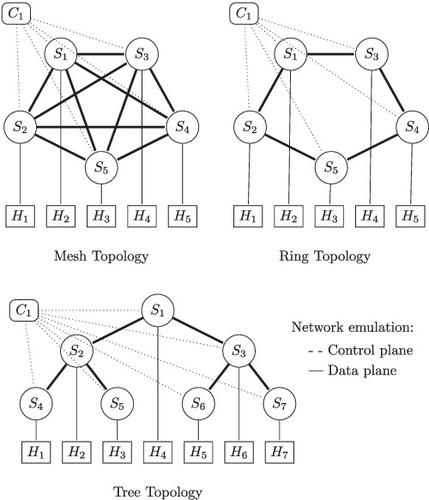当前位置:
X-MOL 学术
›
Int. J. Netw. Manag.
›
论文详情
Our official English website, www.x-mol.net, welcomes your
feedback! (Note: you will need to create a separate account there.)
DockSDN: A hybrid container-based software-defined networking emulation tool
International Journal of Network Management ( IF 1.5 ) Pub Date : 2021-05-05 , DOI: 10.1002/nem.2166 Erick Petersen 1 , Marco Antonio To 1
International Journal of Network Management ( IF 1.5 ) Pub Date : 2021-05-05 , DOI: 10.1002/nem.2166 Erick Petersen 1 , Marco Antonio To 1
Affiliation

|
The Internet has proven to be able to connect billions of devices across the globe. In order to keep pace with today's high demands or even larger services and applications, traditional ways of networking will have to change or update. The future of computer networks needs to be agile without degrading efficiency, capacity, and availability. These new trends push forward the need for network programmability. Software-defined networkings (SDNs) are the future of networking, but in order to deploy newer standards, they have to be tested. Furthermore, this calls for better testbeds that are close to a real environment as possible. Many tools have been proposed to provide a framework for testing newer approaches of networking, but they have come short in various characteristics, limiting the scenarios and their results. Our experience in containers (Docker) and the development of testbeds using this technology has now brought our attention to SDNs. DockSDN provides a tool that meets current and future needs and is our biggest contribution to the scientific community so far. DockSDN is presented in this work, which proposes various benefits and advantages over other tools. One of those benefits is that it uses dockers as building blocks for scenario deployment. Moreover, these scenarios can be done fairly quickly and is fully scalable through local PC hardware or elastic through cloud services. Now, the scientific community will be able to test a wide array of protocols in near real-world conditions, saving financial resources and time.
中文翻译:

DockSDN:基于混合容器的软件定义网络仿真工具
事实证明,互联网能够连接全球数十亿台设备。为了跟上当今的高需求甚至更大的服务和应用程序,传统的联网方式将不得不改变或更新。计算机网络的未来需要在不降低效率、容量和可用性的情况下保持敏捷。这些新趋势推动了对网络可编程性的需求。软件定义网络 (SDN) 是网络的未来,但为了部署更新的标准,必须对其进行测试。此外,这需要尽可能接近真实环境的更好的测试平台。已经提出了许多工具来提供一个框架来测试更新的网络方法,但是它们在各种特性方面都存在不足,从而限制了场景及其结果。我们在容器 (Docker) 方面的经验以及使用该技术开发测试平台的经验现在让我们注意到了 SDN。DockSDN 提供了一个满足当前和未来需求的工具,是迄今为止我们对科学界的最大贡献。在这项工作中介绍了 DockSDN,它提出了优于其他工具的各种好处和优势。这些好处之一是它使用 docker 作为场景部署的构建块。此外,这些场景可以相当快地完成,并且可以通过本地 PC 硬件完全扩展,或者通过云服务实现弹性。现在,科学界将能够在接近真实世界的条件下测试各种协议,从而节省资金和时间。DockSDN 提供了一个满足当前和未来需求的工具,是迄今为止我们对科学界的最大贡献。在这项工作中介绍了 DockSDN,它提出了优于其他工具的各种好处和优势。这些好处之一是它使用 docker 作为场景部署的构建块。此外,这些场景可以相当快地完成,并且可以通过本地 PC 硬件完全扩展,或者通过云服务实现弹性。现在,科学界将能够在接近真实世界的条件下测试各种协议,从而节省资金和时间。DockSDN 提供了一个满足当前和未来需求的工具,是迄今为止我们对科学界的最大贡献。在这项工作中介绍了 DockSDN,它提出了优于其他工具的各种好处和优势。这些好处之一是它使用 docker 作为场景部署的构建块。此外,这些场景可以相当快地完成,并且可以通过本地 PC 硬件完全扩展,或者通过云服务实现弹性。现在,科学界将能够在接近真实世界的条件下测试各种协议,从而节省资金和时间。这些好处之一是它使用 docker 作为场景部署的构建块。此外,这些场景可以相当快地完成,并且可以通过本地 PC 硬件完全扩展,或者通过云服务实现弹性。现在,科学界将能够在接近真实世界的条件下测试各种协议,从而节省资金和时间。这些好处之一是它使用 docker 作为场景部署的构建块。此外,这些场景可以相当快地完成,并且可以通过本地 PC 硬件完全扩展,或者通过云服务实现弹性。现在,科学界将能够在接近真实世界的条件下测试各种协议,从而节省资金和时间。
更新日期:2021-05-05
中文翻译:

DockSDN:基于混合容器的软件定义网络仿真工具
事实证明,互联网能够连接全球数十亿台设备。为了跟上当今的高需求甚至更大的服务和应用程序,传统的联网方式将不得不改变或更新。计算机网络的未来需要在不降低效率、容量和可用性的情况下保持敏捷。这些新趋势推动了对网络可编程性的需求。软件定义网络 (SDN) 是网络的未来,但为了部署更新的标准,必须对其进行测试。此外,这需要尽可能接近真实环境的更好的测试平台。已经提出了许多工具来提供一个框架来测试更新的网络方法,但是它们在各种特性方面都存在不足,从而限制了场景及其结果。我们在容器 (Docker) 方面的经验以及使用该技术开发测试平台的经验现在让我们注意到了 SDN。DockSDN 提供了一个满足当前和未来需求的工具,是迄今为止我们对科学界的最大贡献。在这项工作中介绍了 DockSDN,它提出了优于其他工具的各种好处和优势。这些好处之一是它使用 docker 作为场景部署的构建块。此外,这些场景可以相当快地完成,并且可以通过本地 PC 硬件完全扩展,或者通过云服务实现弹性。现在,科学界将能够在接近真实世界的条件下测试各种协议,从而节省资金和时间。DockSDN 提供了一个满足当前和未来需求的工具,是迄今为止我们对科学界的最大贡献。在这项工作中介绍了 DockSDN,它提出了优于其他工具的各种好处和优势。这些好处之一是它使用 docker 作为场景部署的构建块。此外,这些场景可以相当快地完成,并且可以通过本地 PC 硬件完全扩展,或者通过云服务实现弹性。现在,科学界将能够在接近真实世界的条件下测试各种协议,从而节省资金和时间。DockSDN 提供了一个满足当前和未来需求的工具,是迄今为止我们对科学界的最大贡献。在这项工作中介绍了 DockSDN,它提出了优于其他工具的各种好处和优势。这些好处之一是它使用 docker 作为场景部署的构建块。此外,这些场景可以相当快地完成,并且可以通过本地 PC 硬件完全扩展,或者通过云服务实现弹性。现在,科学界将能够在接近真实世界的条件下测试各种协议,从而节省资金和时间。这些好处之一是它使用 docker 作为场景部署的构建块。此外,这些场景可以相当快地完成,并且可以通过本地 PC 硬件完全扩展,或者通过云服务实现弹性。现在,科学界将能够在接近真实世界的条件下测试各种协议,从而节省资金和时间。这些好处之一是它使用 docker 作为场景部署的构建块。此外,这些场景可以相当快地完成,并且可以通过本地 PC 硬件完全扩展,或者通过云服务实现弹性。现在,科学界将能够在接近真实世界的条件下测试各种协议,从而节省资金和时间。









































 京公网安备 11010802027423号
京公网安备 11010802027423号